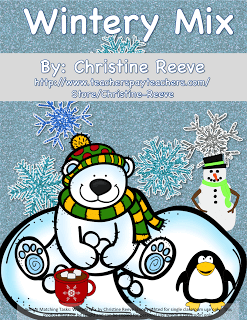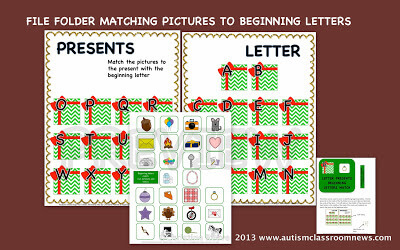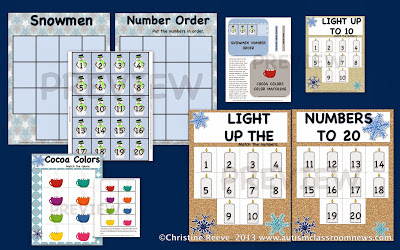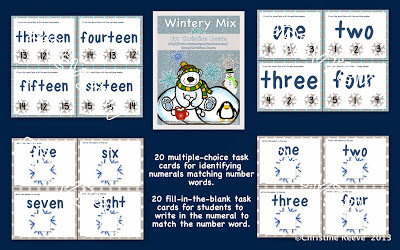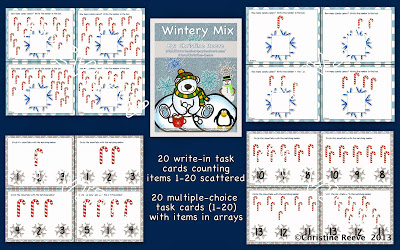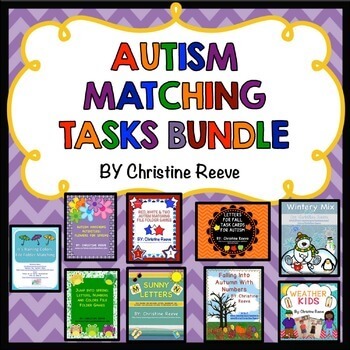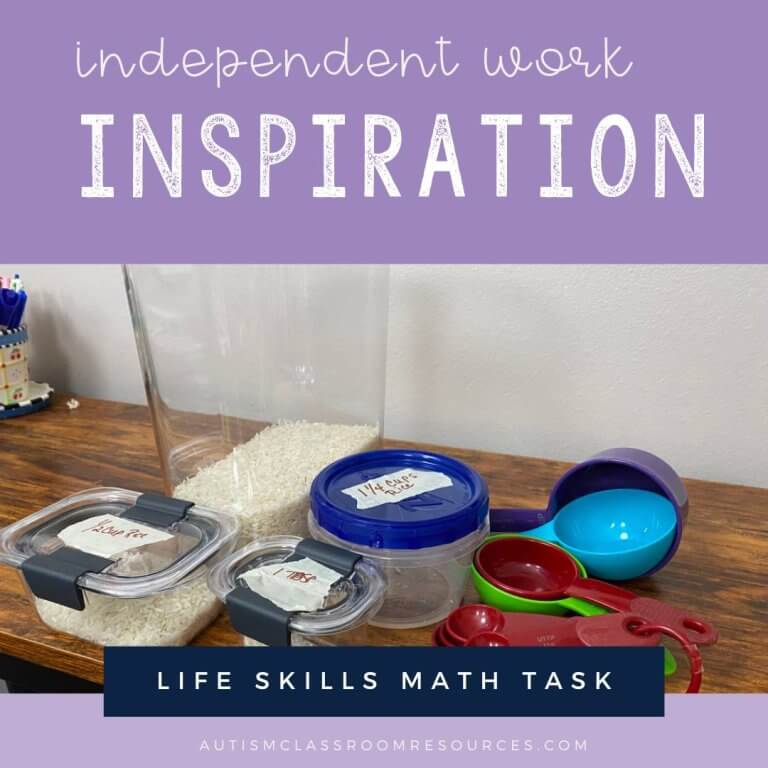Sharing is caring!
Yes it’s that time of year when we actually start thinking of winter. Perhaps the whole snow thing is more appealing to someone who lives in Florida and doesn’t really see it much?
I decided that my last post was entirely too serious so I wanted to do a few little fun things over the next few posts. I want to talk about writing goals and objectives but I’m going to use some of my products as examples for writing them. This is a new product that I just put out this weekend and I love it!! I love all the clip art from the amazing clip artists as well as the variety of tasks I managed to get out of it. This set of matching tasks is now in my store and has also been added to the Autism Matching Tasks Basic Skills Bundle and the Structured Work System Elementary Start Kit. These were growing bundles when I put them out at the beginning of the year and they are NOW COMPLETE! This means that there are now basic matching file folders and task cards for all 4 seasons so that if you have early childhood students or complex learners, they can practice some of the same skills using different materials throughout the year. They are great for providing variety to basic number and letter matching skills and they can be used to teach some of the basic common core standards. I did not include specific holiday materials in these tasks because I know that many schools are not allowed to celebrate holidays like Christmas and sometimes even Halloween. There are some Thanksgiving materials in the fall task cards and there is a witch and Jack O’Lantern task cards, but that’s the beauty of task cards–you can choose not to use them and it doesn’t mean you have to throw out the whole task. I’ve created a variety of materials in each set. Some are just file folders, some are just task cards and some, like this new one, are both. So, let’s take a look.
This is the mainstay of all the basic matching tasks skills–letter matching file folders. Here there are uppercase to uppercase matching, lowercase to lowercase matching, and uppercase to lowercase matching. Each file folder comes with labels for the front and tab and have been designed to avoid having to put Velcro over the letters or important characteristics of the objects (so the letters sit over the cups so the Velcro can be put on the cups). Each one has directions for how to put them together as well.
For each set of tasks I am going to write some possible IEP goals. Please always remember to substitute your child’s name where it says “the student.” And keep in mind that for ALL these tasks, you should use more than 1 set of materials to teach any goal or objective to assure the student generalizes. These are just one tool in the arsenal, not the entire teaching set.
IEP goal / objective using the file folder on their own:
The student will match uppercase and lowercase letters of the alphabet independently given a variety of materials with 90% accuracy. (If you put Velcro on the file folders, it’s easy to check the students’ work and record their progress. Just make sure to record any assistance you provided while they were doing it). You can also cross-list this goal/objective to the common core standard ELA-Literacy RF.K.1d
If you use the materials for instruction with the student,
The student will identify upper and lowercase letters of the alphabet independently when shown on 9/10 trials. (In this situation, you can use the pieces of the file folder to ask the student what the letter is and have him name it. Then you can use the file folders to have him practice the skill). You can also cross-list this goal/objective to the common core standard ELA-Literacy RF.K.1d
I tried to avoid using specific holiday-related items so that you wouldn’t have a problem using them in schools. I think I’m going to make some other tasks that are specifically designed for holidays that you can add in the ones you are allowed. However, I just couldn’t pass up these presents from Ashley Hughes once I realized if I put the letter over the bow, you could put the Velcro in the middle of the present and not cover anything up! I know it’s not rocket science, but it’s the little things that make me happy! This file folder matches beginning letters to words. This is a task that is included in a number of the bundles, although not all, and I tried to make sure I used different items each time so you can mix and match if you buy the bundle. I also kept the cards the same size in this one as in previous ones for the same reason.
IEP goal / objective: Given a picture of a common object, the student will identify the letter with which the word begins with 80% accuracy over a 3 day period.
Again, this could be done in instruction with the teacher or as independent work. I added over a 3-day period in this instance because sometimes it’s important to indicate how long the student has to show the performance so that you aren’t averaging too much (9 weeks) or too little (1 day) of the data to make the decision. I will talk more about that in a later post. Also it is important to use a variety of materials to teach this skill beyond this file folder.
I just loved these little penguins from Dancing Crayon so I had to use them but I didn’t want the Velcro to cover them up. So, I added a letter sequencing file folder, similar to the one from Sunny Letters. In this one, you put Velcro on the blue squares and Velcro on the back of the penguins. Then students can put the letters in order using a blank template, or you can provide anchors by putting letters in to keep them on track if they can’t do the whole alphabet by themselves. So for instance, you might put in A, I, M, and Y so that if they get off track they have a clue. Or for some beginning learners you can put in every other letter and have them fill it in, or just leave out the ones they have learned. You can also use the letters for explicit instruction and then have them put the letter on the square you point to when they name it. You also could use the pictures from the Letter Presents to have the student alphabetize the items.
IEP goal / objective: The student will put letters in alphabetical order from A to Z with 100% accuracy. (this is such a basic skill that it really requires a higher level of mastery before moving on)
You also could use the pictures from the Letter Presents to have the student alphabetize the items.
IEP goal / objective: The student will alphabetize items by placing them in order from A to Z on a grid with 90% accuracy.
The next set of tasks are number-oriented. Light It Up to 20 and Light Up to 10 are 2 file folders for matching identical numerals. The Velcro can be placed above the number on the candle so it doesn’t interfere with reading them. Snowmen Number Order is a file folder for placing numerals in order. You can start the student out at different numbers to meet the common core standard K.CC.A2. You can use just the Number Order side of the file folder for students counting 10 or less numbers or both sides for up to 20. You can add anchors into the numbers to have students fill in the missing numbers, or you could have the student use the numbers and grids to skip count by twos or threes up to 20. Finally, Cocoa Colors is a simple color matching task that was designed for learners just learning to match or it can be used to work on color identification in instruction.
IEP Goal: The student will count forward beginning with numbers other than 1 up to 20 by placing numerals in order with 90% accuracy (K.CC.A2).
These objectives might work with this goal or separately.
Objective: The student will count forward beginning with 1 to 20 by placing numerals in order with 90% accuracy.
Objective: The student will fill in missing numbers when given a template (e.g., place 2 before 3 and 4 after 3 when the 3 is provided) with at least 3 numbers when ordering numbers up to 20 with 90% accuracy over 3 consecutive sessions.
Goal/Objective: The student will match numerals to identical numerals up to 20 with 100% accuracy for 3 consecutive days.
Goal/Objective: The student will identify colors when asked during explicit instruction with 90% accuracy for 3 consecutive sessions.
Goal/Objective: The student will match identical items by color with 90% accuracy over 3 consecutive sessions.
The rest of the numeral / math-related activities are task cards. I like task cards because you can easily individualize just the items that the student needs to work on. I created each set with 2 possible ways to answer. One set is designed with multiple choice answer so the students just need to circle the answer with dry erase markers or mark it with a clothespin or paperclip. The other set is designed for the student to write the correct numeral in the box with a dry erase marker (assuming the cards are laminated. Both sets are shown above for identifying the numeral when reading the number word. The student reads the number word and either circles or write in the corresponding numeral. There are cards for 1-20 of each type.
IEP Goal: The student will associate numerals with corresponding number words up to 20 with 90% accuracy over 3 consecutive sessions.
One of the advantages of task cards is you can break the objectives down easily by the sets of numbers you want him to master each quarter and just use those cards as you teach. So, if the first objective was associating numbers 1-5 words with the corresponding numerals, you would just use the first five cards. Then when those are mastered, you could add the next 5.
And finally, the last 2 sets of task cards are set up with either multiple choice answers or write in answers for the same cards. The cards involve counting candy canes and identifying the quantity. On the multiple choice cards the candy canes are set up in orderly arrays whereas in the write-in cards they are scattered on most cards, so they are a bit more difficult. Students count the candy canes and either write in the number or mark the correct number. These sets are designed to work on K.CC.A.3, K.CC.B.4 and K.CC.B.5 that all focus on connecting counting objects to numbers.
Possible IEP goals:
Given an array of objects up to 20 (or 10) and asked how many?, the student will count the objects and write (or choose) the corresponding number with 85% accuracy over 3 consecutive sessions.
Given scattered objects up to 20 (or 10) and asked how many?, the student will count the objects with 1-1 correspondence and write (or choose) the correct number with 85% accuracy over 3 consecutive sessions.
So, all of these are assembled in one product–Wintry Mix. It is priced so it’s less than $1 per task. They can also be purchased as part of the bundles as described above and pictured below. If you have previously bought either of the 2 below, you can download Wintery Mix for free. Just go to My Purchases on TPT and re-download the file.
If you have older students or need more functional skills, the secondary bundle might be for you. Thanks for reading, following and for all of your support!
Until next time,


